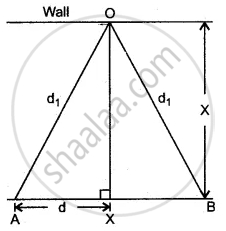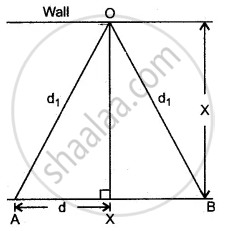Advertisements
Advertisements
Question
A cannon is fired at A (see diagram). An observer at B hears two sounds. The first sound is heard after 1 second and the second 3s after the observer sees the flash. (Velocity of sound = 340 ms−1)
(i) Why does the observer see the flash before he hears the sound?
(ii) Calculate the distance x between the observer and the wall.

Solution
(i) An observer sees the flash first and hears the sound afterward because the velocity of light which is equal to 3 × 108 ms−1 is much higher than the velocity of sound which is 340 ms−1.

(ii) v = `(3"d"_1)/"t"`
An echo or the second sound is heard after 3s.
∴ t = 3s
∴ 340 = `(3"d"_1)/3`
∴ d1 = `(340xx3)/2`
= 510 ms−1
In right Δ AOX: d12 = OX2 + d2 = x2 + d2
∴ d12 − d2 = x2 ................(i)
but 2d = v × t .............(where t = 1s)
2d = 340 ..........(v = 340 ms−1 and t = 1s)
∴ d = 170 m ....................(ii)
From equation (i) and (ii),
x = (510)2 − (170)2 = `10sqrt2312`
∴ x = 481 m
The distance between the observer and the well is 481 m.
APPEARS IN
RELATED QUESTIONS
Select the correct alternative :
We can distinguish a shrill sound from a flat sound by its
List the measures that you will take when designing a sound-proof room.
Distinguish between longitudinal and transverse waves.
What is a transverse wave? In which medium: solid, liquid or gas, can it be produced?
Draw displacement-time graph of a wave and show on it the amplitude and time period of wave.
In which medium the speed of sound is more: humid air or dry air? Give a reason to your answer.
The heart of a man beats 75 times a minute. What is its (a) frequency and (b) time period?
Sound is a ______ wave and needs a material medium to travel.
Sound can travel through solids, gases, liquids, and even vacuum.
What are the uses of infrasonic sound?
